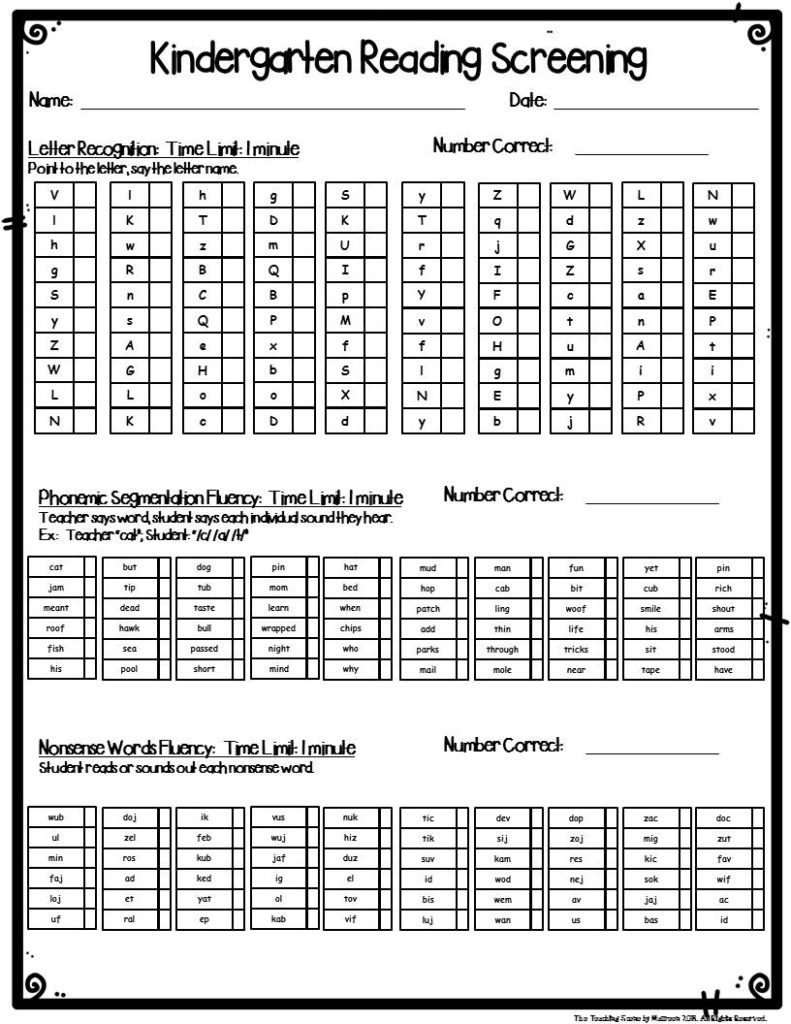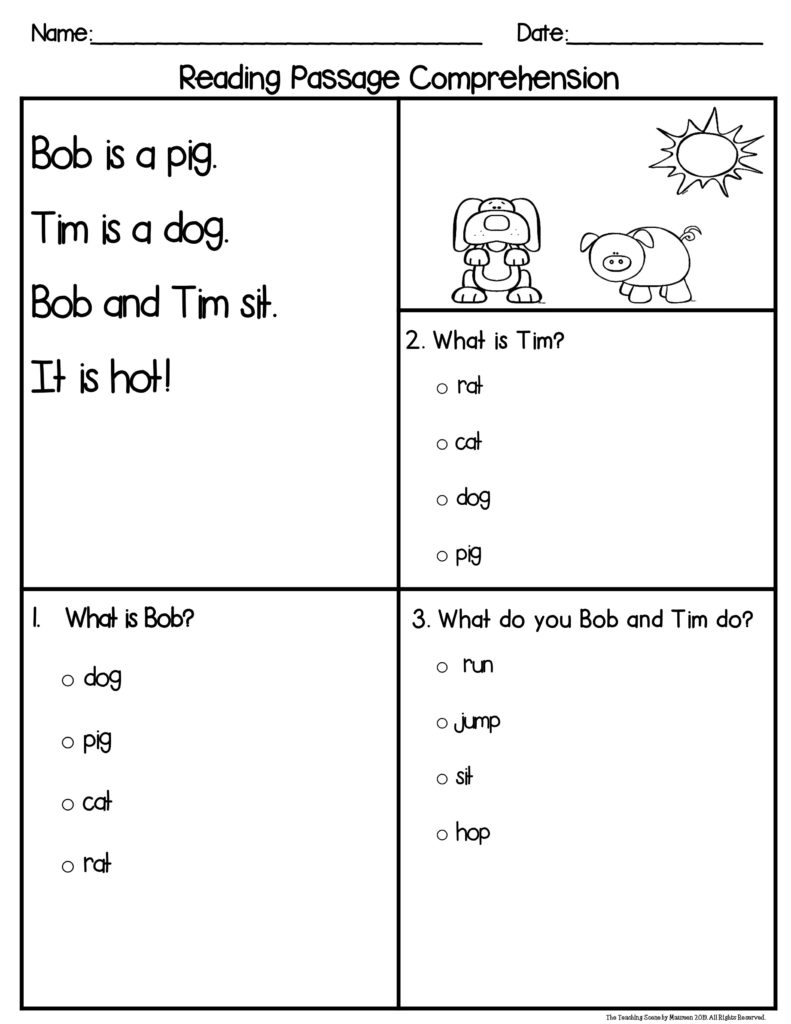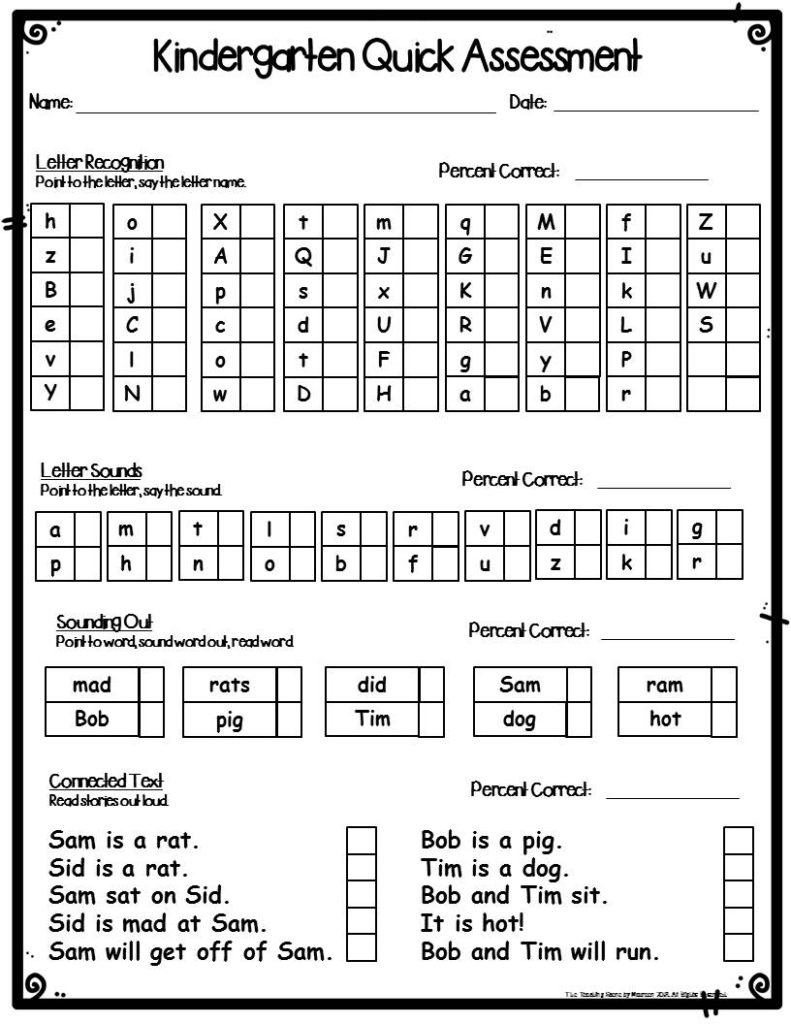Have you been wondering what kindergarten informal reading assessments you could use for your students? Although there are others, here is a list of seven essential kindergarten informal reading assessments. Included is an explanation of what each test measures as well as examples of assessment questions.

To begin with, it is best to give the assessments listed at least 3 to 4 times during the school year and if possible, one-on-one to a kindergarten student. This allows the teacher the most accurate data and the kindergartner a less distracting testing environment.
1. Letter & Sound Recognition
First, students must be familiar with the upper and lowercase letters of the alphabet. In fact, it is very important in the development of reading skills.
Example Assessment Questions:
Show student one letter at a time and ask:
- Can you tell me what letter this is?
- Can you tell me what sound it makes?
2. Concepts of Print
Second, the concept of print usually is learned as children are shown books and are read to at home and at school. In general, the concept of print includes the understanding that print carries meaning and that books have letters, words, sentences and spaces. Moreover, books have certain parts and are read in a certain way.
Sample Assessment Questions:
Give the student a book and ask the following questions. “Can you show me”:
- a letter, a word, a sentence, a space
- the front or back of the book
- where should I start reading the story
- how should I hold the book
- title of the book

3. Phonological Awareness
Next, to demonstrate phonological awareness, a student must demonstrate the following:
- shows the ability to segment a sentence
- identify words that have the same ending sound
- separate or blend words the way they are pronounced
- blend the first sound in the word and the rest of the word
Example Assessment Questions:
- How many words are in this sentence? “I am happy?”
- Do these words rhyme? (cat, hat) (men, tan)
- Can you tell me the two parts of the word, upset?
- What word does these sounds make? /c/ /at/
4. Phonemic Awareness
Somewhat like phonological awareness, phonemic awareness examines a student’s knowledge of how individual sounds make a word. This includes the following skills:
- matching words that begin with the same sound
- isolating a single sound from a word
- blending individual sounds into a word
- segmenting a word into individual sounds
- manipulating sounds in a word
Sample Assessment Questions:
- Which words have the same beginning sounds? (cat, top, can)
- What is the first, last or medial sound in the word cat?
- What word do these sounds make? /t/ /o/ /p/
- What sounds do you hear in the word top?
- Say the word man without the /m/ sound.
- Say top, now change /t/ to a /m/ what word do you have?
Here is an example of a Kindergarten Reading Screening.
5. Reading Fluency
Reading fluency relies on the kindergartener’s ability to read. Some students may be able to be tested at the beginning of the year, while others must have a stronger foundation on the above skills before being able to get a reading fluency score.
This informal assessment simply is how many words a child reads correctly in one minute. Words that are skipped or not pronounced correctly are not counted.
Administrating assessment:
- choose appropriate passage for student to read aloud
- have student read for one minute
- record words read correctly
- total equal student’s oral reading fluency
6. Oral Reading Accuracy
The next kindergarten informal reading assessment is oral reading accuracy. This test gives the teacher insight into a student’s reading level and how that student may use reding strategies to decode unfamiliar words.
Steps to administrating assessment:
- choose a book that is appropriate but unfamiliar to student
- ask student to read story aloud
- as student reads note what is read correctly or incorrectly
- pay attention to student’s behavior, is the student using context clues, structure and visual cues to read words or gather meaning
- intervene as little as possible when student is reading
- after reading as student to retell story, record student responses
Observation notes during an oral reading assessment:
- mastered directionality and letter/sound correspondence
- self-correct errors
- decode unknown words
- pace of reading
- expression when reading
- is retelling accurate
To calculate a student’s oral reding accuracy you simply divide total words read correctly by the total words read. For example, if a student read a story that had 100 words and made 5 errors, they would have a 95% oral reading accuracy.
7. Reading Comprehension
Finally, reading comprehension assessments are the most common type of published reading test available. However, it is the most difficult test to give to younger age children who are just learning how to read.
A typical reading comprehension test would have students reading a passage that is appropriate for their age or grade level and then asking detailed questions about the context of the passage.
Just as the previous two assessments, this type of test may have to wait until the kindergarten students has a stronger foundation on the readiness skills of reading.
However, there are alternative ways to assess a student’s reading comprehension by using a text that is read to them or a retelling of a story they were able to read themselves.
Observations to note, can the student:
- tell what happened in story in their own words
- include story parts (characters, setting, events, problem, solution)
- identify main idea and supporting details
- use vocabulary found in the text
- retelling minimal, adequate or very complete
Here is an example of a Kindergarten comprehension page.
It is important to realize that Kindergarten informal reading assessments provide teachers with valuable information about each one of their students reading ability. It allows them to modify instruction to meet the needs of the students and provides a total picture of each student’s strengths and weaknesses as a reader.
Grab a free Kindergarten Quick Assessment Form Here!
Find some more Kindergarten assessment tools and ideas in my store, The Teaching Scene by Maureen.
To read more topics about assessments check out my blog, “Seven Effective First Grade Assessment Tools”


